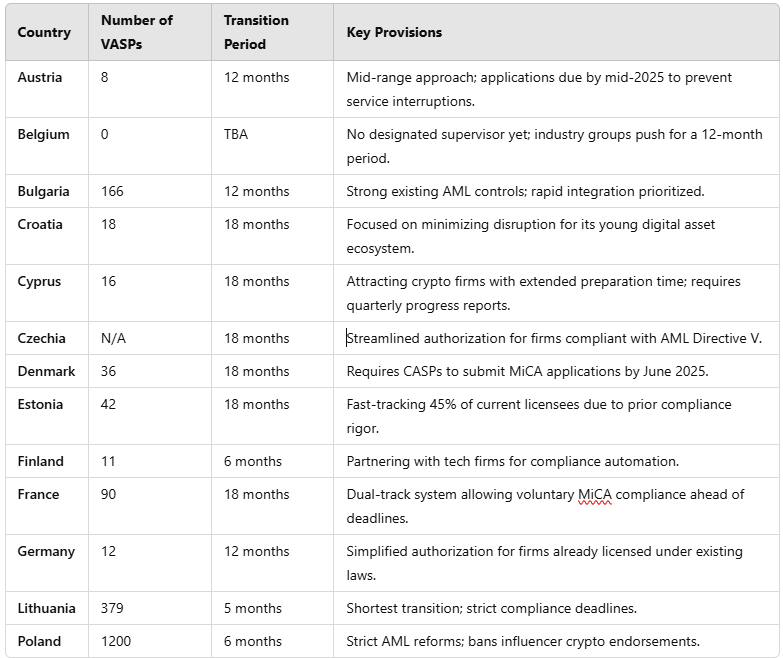The European Union’s Markets in Crypto-Assets Regulation (MiCA) represents a landmark framework aimed at harmonizing crypto regulation across the 27 EU member states and three European Economic Area (EEA) states. However, as implementation begins in January 2025, notable discrepancies in national transitional regimes, supervisory approaches, and enforcement strategies create a complex landscape for Crypto Asset Service Providers (CASPs).
MiCA’s Core Framework and Scope for National Discretion
MiCA aims to replace fragmented national regulations with a unified framework, facilitating passporting across the EU while ensuring financial stability and investor protection. Key pillars include:
Licensing Regimes: Mandatory authorization for CASPs, issuers of asset-referenced tokens (ARTs), and electronic money tokens (EMTs). Stablecoin issuers must meet reserve requirements.
Market Integrity Rules: Prohibitions on insider trading and market manipulation.
Consumer Protections: Standardized disclosure, custody, and operational requirements.
However, MiCA grants national regulators discretion in key areas:
Transitional Periods: Article 143(3) allows member states to shorten the default 18-month transition for legacy CASPs.
Supervisory Approaches: National Competent Authorities (NCAs) determine enforcement priorities, penalties, and compliance expectations.
Ancillary Regulations: Areas such as taxation, anti-money laundering (AML) compliance, and marketing restrictions remain subject to national laws.
Jurisdictional Differences in Transitional Periods and Grandfathering Arrangements
While MiCA provides an 18-month transition period for existing CASPs, individual countries have adopted varying approaches, creating a fragmented implementation landscape.

These variations create challenges for CASPs operating across multiple jurisdictions. For example, a company providing services in both Lithuania (5-month transition) and France (18-month transition) must adhere to Lithuania’s stricter timeline, requiring complex compliance strategies.
Key Compliance Challenges and Strategic Considerations
1. Cross-Border Operational Complexity
CASPs must adhere to the shortest transitional timeline within their operating jurisdictions.
Entities operating in states with extended grandfathering periods (e.g., France) may find their cross-border services restricted by shorter deadlines elsewhere (e.g., Lithuania).
Strategic incorporation in jurisdictions with streamlined MiCA authorization (e.g., Estonia, Germany) can offer competitive advantages.
2. Market Fragmentation Risks
Shorter transitions in Lithuania and the Netherlands may favor domestic firms over cross-border players, reducing competition.
The European Securities and Markets Authority (ESMA) reported a 22% decline in pan-EU crypto transactions due to compliance uncertainty.
3. Divergent Enforcement and Supervisory Practices
MiCA enforcement varies significantly across NCAs, affecting CASP compliance obligations.
Spain & Italy impose additional capital and qualification requirements for CASPs.
Bank of Spain requires a €2M minimum capital for CASPs, exceeding MiCA’s base requirements.
Italy’s CONSOB mandates certification exams for CASP executives.
Netherlands, Ireland, and Sweden implement risk-based oversight:
Netherlands (AFM): Monitors CASPs based on transaction volume and retail exposure.
Ireland (CBI): Focuses on algorithmic trading and cross-border activity.
Sweden (FI): Prioritizes environmental impact assessments for proof-of-work (PoW) CASPs.
4. Marketing and Taxation Fragmentation
While MiCA standardizes some disclosure requirements, national regulators impose additional restrictions:
France: Requires pre-approval for all crypto advertisements targeting minors.
Belgium: Bans celebrity-endorsed crypto promotions.
Portugal: Limits crypto advertising between 6 PM and 6 AM.
Taxation: MiCA does not harmonize tax policies, leading to disparities in capital gains treatment across states.
Key MiCA Implementation Deadlines and Strategic Recommendations for CASPs
Critical Deadlines
30 December 2024: General MiCA provisions take effect.
30 June 2025: ART/EMT rules apply.
National Deadlines:
France: Existing PSANs must convert to MiCA licenses by 31 March 2025.
Italy: Crypto derivatives ban under MiCA begins 1 July 2025.
Poland: Mandatory KYC for all crypto transactions above €1K starts Q3 2025.
Strategic Recommendations
Jurisdiction Selection: Prioritize streamlined licensing states (Estonia, Lithuania) and favorable tax regimes (Germany, Portugal).
Transition Planning: Align applications with shorter transitional periods to ensure uninterrupted operations.
Compliance Architecture: Implement modular compliance frameworks adaptable to national AML and marketing rules.
Liquidity Management: Monitor reserve requirements for ARTs/EMTs, especially in strict jurisdictions like Germany (130% collateral).
Conclusion
While MiCA seeks to create a unified EU crypto market, national regulatory differences persist, requiring CASPs to adopt an agile, jurisdiction-specific compliance strategy. Successfully navigating MiCA means anticipating challenges like France’s stringent advertising rules, Germany’s rigorous enforcement, and Estonia’s tech-driven oversight.
Although MiCA reduces fragmentation compared to the pre-2024 landscape, the EU digital assets ecosystem will remain a patchwork of national interpretations, necessitating continuous regulatory monitoring and adaptive operational planning.



